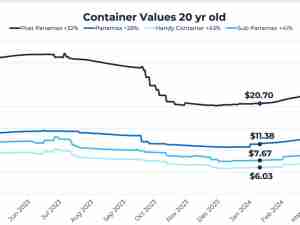China iron ore imports as good they get, for now
By: Reuters | Dec 10 2013 at 06:07 PM | Maritime
China’s record imports of iron ore in November may be as good as they get for a while as a series of factors points to a moderation in the next few months.
Imports surged 18.3 percent from a year earlier to reach 77.84 million tons in November, surpassing the prior record of 74.58 million tons in September.
For the year to date, imports stand at 746.1 million tons, up 10.9 percent over the same period in 2012, making iron ore one of the most imported among China’s purchases of major commodities.
Crude oil imports are up only 3.2 percent in the first 11 months of 2013, soybeans have gained 6.6 percent and unwrought copper is down by 4.8 percent.
But iron ore imports may show more moderate growth in coming months amid the winter lull in demand for steel, higher spot prices, rising freight rates and a steepening in the backwardation of the swaps curve.
Iron ore imports show some seasonality, usually peaking between November and January, before tailing off in the first quarter.
While this doesn’t preclude the possibility of a gain in imports in December, this year may be similar to the winter of 2011-12 when imports peaked in November, rather than 2012-13 when they topped out in December, or 2010-11 when January was the high.
The reason imports of the steelmaking ingredient may not peak in December or January is that rising prices have in the past acted as a dampener on demand.
Spot iron ore in Asia .IO62-CNI=SI closed at $139.20 a ton on Dec. 6, near the $139.70 on Dec. 4, which was the highest price in almost four months.
The gains in both prices and volumes have been driven in recent months by a re-stocking in inventories in China, and an improving outlook for steel demand amid signs of stronger infrastructure and other construction spending.
However, inventories of iron ore at Chinese ports have continued to rise, reaching 87.4 million tons in the week to Dec. 1, according to data from Mysteel, an industry information service.
This is up from just under 80 million tons in mid-November and traders report that mills have been building inventories in recent weeks.
But once iron ore stocks reach comfortable levels, and at the current level of more than a month’s imports they are probably there, it’s likely mills will buy only as much as they consume.
Spot Prices Gaining
Rising spot prices have in the past also seen the rate of import demand growth slow, and iron ore has gained more than 6 percent in the past six weeks.
While this isn’t a sharp enough increase to spark demand destruction, it’s likely to give buyers pause for thought, especially with freight rates soaring in recent weeks.
The Baltic Dry Index had jumped 46.7 percent since hitting a two-month low of 1,483 on Nov. 22.
The rising cost of shipping, coupled with higher spot prices, will reduce the appeal of importing iron ore, and also serve to make domestic supplies more attractive.
However, prices may not have much further to rise in the short term as the Singapore iron ore swaps curve is pointing to an easing, with the backwardation increasing in recent weeks.
So far this year, an increase in backwardation has been followed by a decrease in prices, while a narrowing has resulted in gains.
In February this year, just as iron ore reached its high for the year of $158.90 a ton, the front-month swap was 12.7 percent higher than the six-month.
Prices then slumped to $110.40 a ton by the end of May, and by the start of June the front-month swap was just 1.9 percent above the six-month. At that time the curve went into contango from eighth to tenth months.
From the low at the end of May, prices have climbed to current levels, but the backwardation has recently steepened, indicating prices may decline in the next few weeks.
In morning trade on Dec. 9 the front-month swap was at $137.83 a ton, a premium of 8.7 percent to the six-month, while a month ago the premium was 8.3 percent and three months ago it was 6.6 percent.
So while current high prices and freight rates may curb some import appetite, this may only be temporary as iron ore demand is expected to continue its strong growth in 2014.
Imports may rise to 850 million tons in 2014, a gain of 6.3 percent over 2013’s forecast 800 million, the China Metallurgical Industry Planning and Research Institute, an industry group that provides consultancy for government policies, said on Dec. 6. (Reuters)








